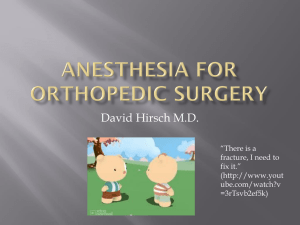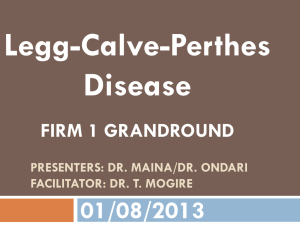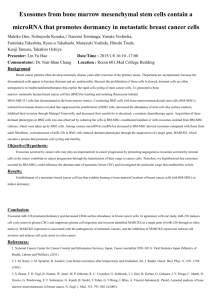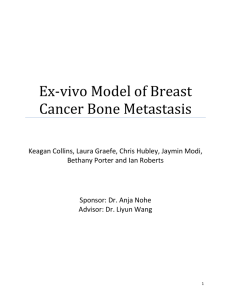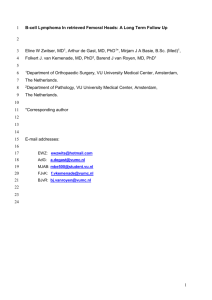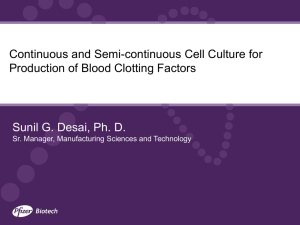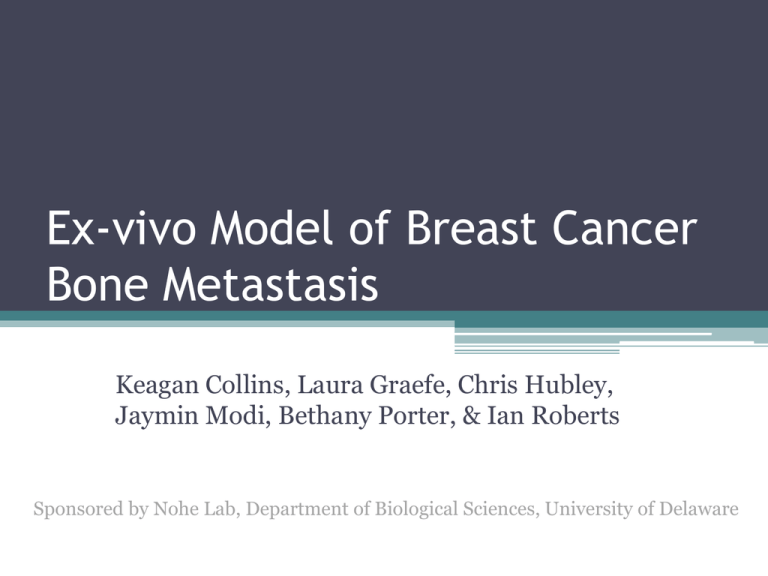
Ex-vivo Model of Breast Cancer
Bone Metastasis
Keagan Collins, Laura Graefe, Chris Hubley,
Jaymin Modi, Bethany Porter, & Ian Roberts
Sponsored by Nohe Lab, Department of Biological Sciences, University of Delaware
Background & Significance
• Dr. Anja Nohe is an Assistant Professor in the
Department of Biological Sciences at UD
• Interested in metastasizing breast cancer and
maintaining cell viability within a femoral head
• Current treatments and diagnostic capabilities
for metastasized breast cancer are not very
effective and research into the field stands to
change the disease
Project Scope
• To develop a perfusion bioreactor that maintains
cell viability within a femoral head with the
purpose of metastasizing breast cancer cells
Wants & Constraints
Constraints
Wants
1. Bone remains viable
for at least ten days
2. Project deadline
3. Sterility of bioreactor
4. Ability to test for cell
viability
5. Integrity of
vasculature
1. Ease of use
2. Efficient use of
resources
3. Ideal size
4. Cost effective
Biological Metrics
Additional Metrics
Cannulation
• Two possible methods
▫ Through existing vasculature
▫ Through drilled entry points
• Dependent on individual bone sample
Bone Type
• Originally adult bovine femoral head
▫ Bone cells were no longer viable
• First trial used juvenile bovine (veal) femoral heads
▫ Bone will be acquired within 24 hours
▫ Many cells should remain viable
Final Design Concept
Final Design Concept
Bioreactor Chamber
Vibration Table
Cost Analysis
Initial Trial - Bovine
Initial Trial - Bovine
Testing
• Cell Viability
▫ Glucose testing
▫ pH testing
• Contamination
• Cannulation/perfusion
• Vibration table
Glucose and pH testing
Trial One Results
Glucose Usage (mg/h) at a function of Time
140
Glucose Usage Rate (mg/h)
120
100
80
60
40
20
0
0
50
100
150
Time (hours)
200
250
Trial One Results
Bioreactor Media pH as a Function of Time
9
8.5
8
pH
7.5
7
6.5
6
5.5
5
0
50
100
150
Time (hours)
200
250
Trial Two Results
Approximately 99% initial cell viability
92% viability maintained in 12 hours
Failure Analysis
• Possible methods of failure
▫
▫
▫
▫
Contamination
Initial cell viability
Catheter placement
Media viability testing
Media samples taken every 36 hours
Design Evaluation
• Major metrics met
▫ Viability maintained
▫ Vasculature intact
▫ Mechanical loading conditions
▫ No apparent bacterial contamination
• Complications
▫ Fungal contamination
Path Forward
• Full length 10 day trial with human
femoral head
• Full length 10 day trial during which
metastatic breast cancer cells are
introduced into human femoral head
• Study of effects of metastatic breast cancer
on human femoral heads
References
[1] Carreau, A., B. El Hafny-Rahbi, A. Matejuk, C. Grillion, and C. Kieda. "Why Is
the Partial Oxygen Pressure of Human Tissues a Crucial Parameter? Small
Molecules and Hypoxia." J Cell Molecular Medicine (2011): 1239-253. Pubmed.
Web.
[2] Kellum, John A. "Determinants of Blood PH in Health and Disease."
Determinants of Blood PH in Health and Disease (2000): 6-14. Pubmed. Web. 3
Sept. 2013.
[3] De Oliveira, Mônica Longo, Cássia T. Bergamaschi, Orivaldo Lopes Silva, Keiko
Okino Nonaka, Charles Chenwei Wang, Aluízio Barbosa Carvalho, Vanda
Jorgetti, Ruy R. Campos, and Marise Lazaretti-Castro. "Mechanical Vibration
Preserves Bone Structure in Rats Treated with Glucocorticoids." Bone 46.6
(2010): 1516-521. Print.
[4] Kubo, T., K. Kimori, F. Nakamura, and S. Inoue. "Blood Flow and Blood
Volume in the Femoral Heads of Healthy Adults According to Age:
Measurement with Positron Emission Tomography (PET)." Ann Nucleic
Medicine (2001): 231-35. Pubmed. Web. 3 Sept. 2013.
[5] Fisher, J.P., & Yeatts, A.B. (2011). Bone tissue engineering bioreactors:
Dynamic culture and the influence of shear stress. Bone, 48 (2), 171-181
[6]Metastatic Breast Cancer. (n.d.). Patient Resource. Retrieved September 6,
2013, from http://www.patientresource.com/Metastatic_Breast.aspx
Special thanks to…
• Advisor: Dr. Liyun Wang, Department of
Mechanical Engineering
• Sponsor: Dr. Anja Nohe, Department of
Biological Sciences
• Hemanth Akkiraju and Jeremy Bonor in the
Nohe Lab
• Dr. Gwen Talham, Department of Animal Care
• Dr. Robert Sikes, Director of Center for
Translational Cancer Research, Department of
Biological Sciences
Questions?



